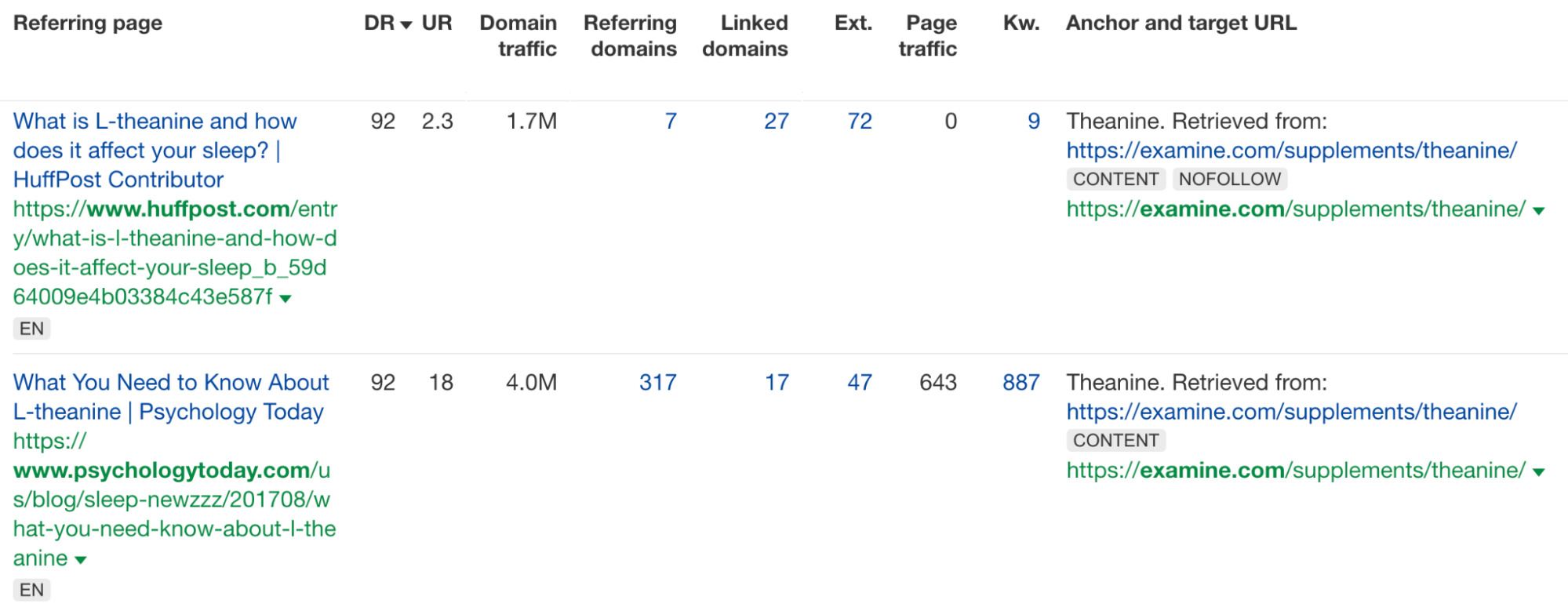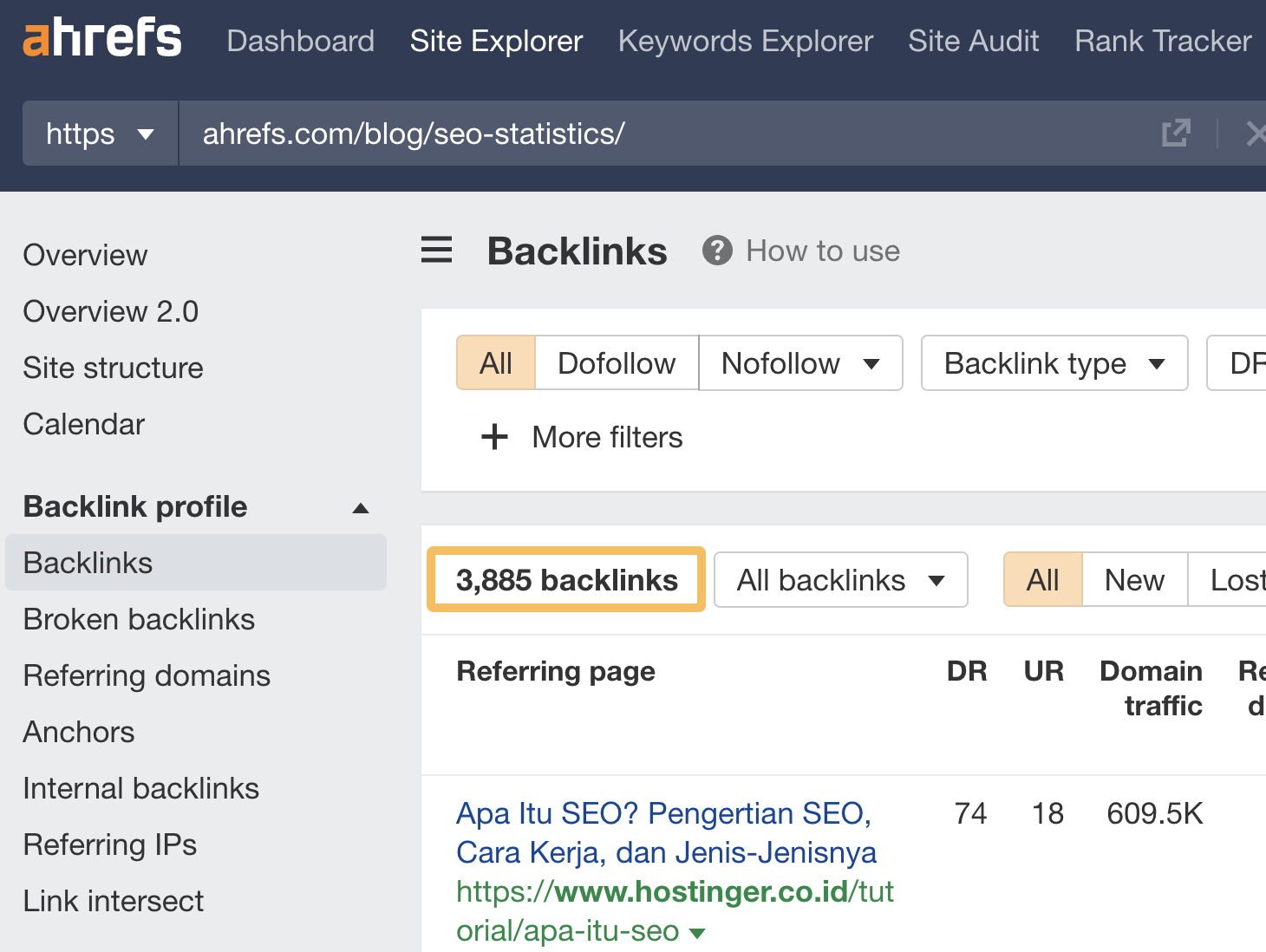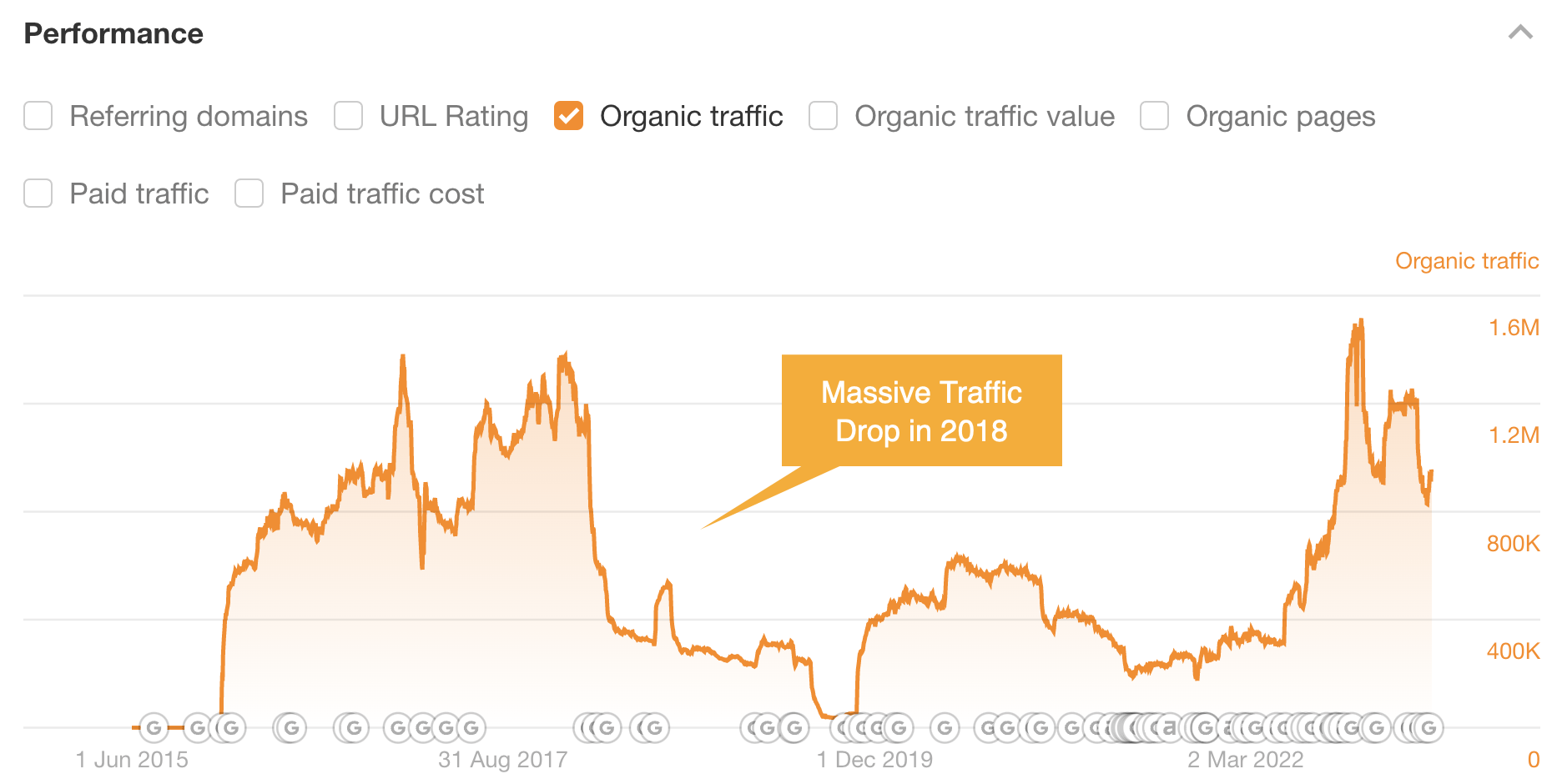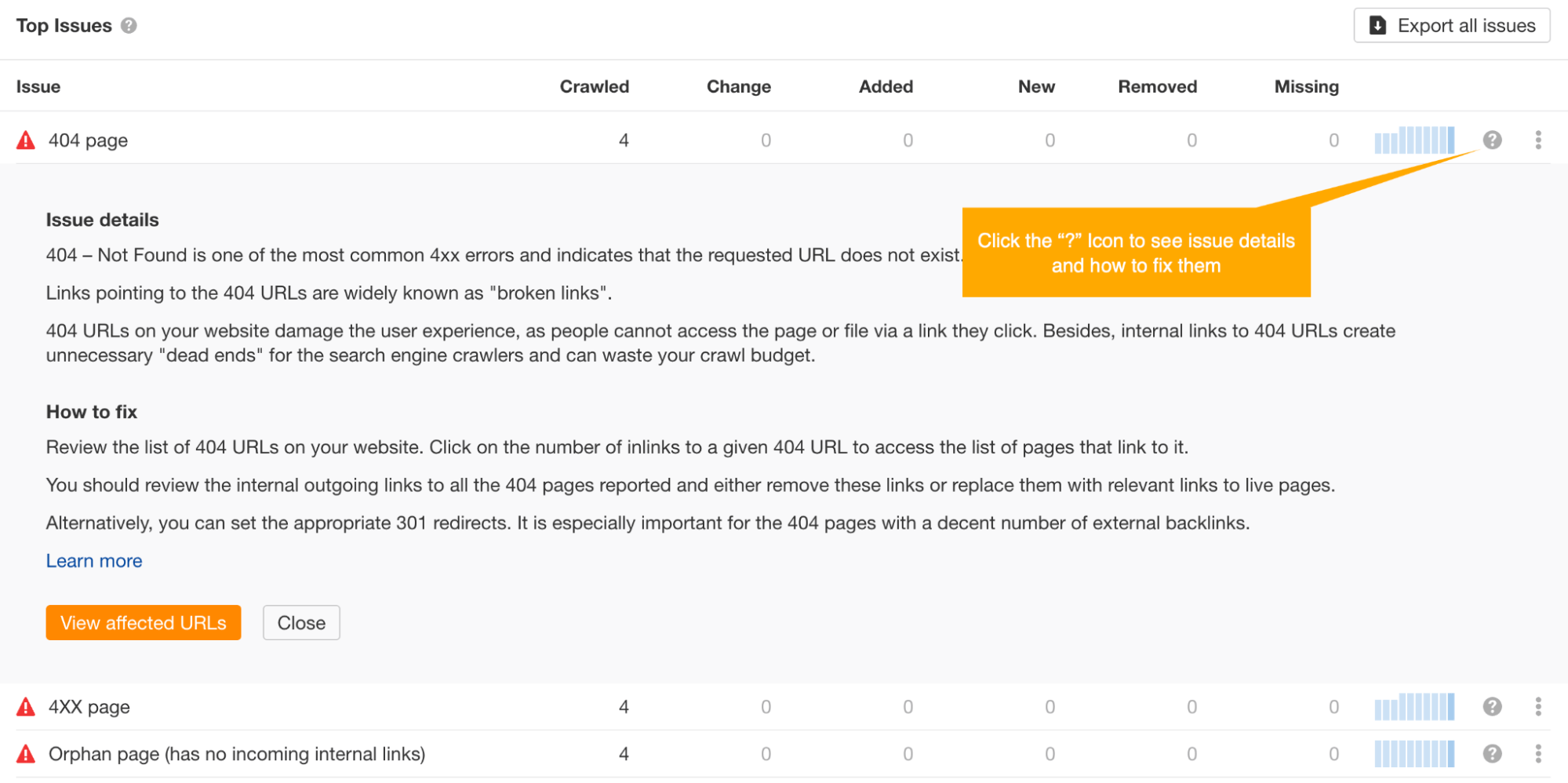SEO
7 Lessons to 1 Million Monthly Visits

Examine.com was able to reach over 1 million monthly visitors from Google search results. The best part? It did so without any manual backlink outreach or even having a focus on SEO.

That’s not all. Despite not using outreach, it acquired links from sites like The New York Times and Forbes—on autopilot.
How? I spoke with the co-founder, Sol Orwell, to find out.
He shared the site’s entire approach to SEO with me, including how it recovered from a 90% traffic drop and how the business grew to over 30 employees. Here are a few lessons learned from a multimillion-dollar company.
Examine provides evidence-based analysis of supplements and nutrition through its team of researchers with varying backgrounds, including PhDs in physiology, neurobiology, nutrition, and more.

It makes money by selling a subscription service that gives you access to its in-depth research on health conditions and goals. So if you want to learn how to improve osteoarthritis, for example, you can access the most actionable and up-to-date research that exists online.
If you were paying attention, you’d notice I already revealed some of Examine’s SEO secrets. But let me break down the seven specific SEO lessons you can learn from it:
Examine has received dozens of extremely high-quality links from The Guardian. How? Sol attributes it to a by-product of caring about people.
He met someone years before they ever got a link, and that person happened to make a connection with a writer for The Guardian and mention Examine to them—the writer loved what they saw and now regularly links to them in their articles.

Of course, Examine also needed to have content worthy of receiving these links. Relationships alone won’t build links for you, at least not the best links.
But how can you build relationships that lead to backlinks?
Mostly from meeting and assisting as many people as possible. One of the best ways to do that is by going to in-person meetups and events. But if that’s not possible, being active in forums and online communities is also a great option.
Check out these online marketing communities to get started. Just remember—you’re trying to build genuine relationships, not just manipulate people into linking to your website. Be helpful and give without expecting anything in return.
This is where Examine truly shines. It summarizes over 150 studies every month with key findings and actionable takeaways.
Unique data is one of the best ways to capture extremely high-quality backlinks.
For example, Examine’s research page on L-theanine contains all of its findings about L-theanine’s effects on the body in a single, easy-to-digest page with unique data.

This page has attracted over 1,000 backlinks. Some of these links are from strong sites like Psychology Today and The Huffington Post and were acquired organically without outreach.

Don’t worry—you don’t need to create 150 study summaries every month to use this strategy. Instead, just a few targeted statistics summary pages can do the trick.
For example, we created a summary of SEO statistics. It ranks #1 on Google for keywords like “seo statistics” and has accumulated nearly 4,000 backlinks.

Want to learn how we did it? Check out our full case study.
In addition to incredibly strong backlinks, Examine regularly receives mentions on the “Huberman Lab” podcast—one of the most renowned science and health podcasts in the world.
This is because it publishes ridiculously good content.
So what’s its secret?
Well, it lays out its exact content creation process on its editorial policy page:
- Researcher and reviewer create outline to fully address the question/topic at hand
- Researcher writes the article
- Article is copyedited by content editor
- Article is edited by editor
- Article is reviewed by reviewer
- Corrections and clarifications are incorporated at every level
- Article is published on the website
It also discusses how it minimizes bias.
All in all, it has several layers of edits and reviews for each piece of content that’s published on the site.
More importantly, these reviews are done by “a diverse team of researchers who fully read all relevant scientific papers completely and have no conflicts of interest.”
This rigorous process is expensive and time consuming, but it has to be in the health and science space. More lax spaces can get away with much less scrutiny, but you still need to do the work to ensure your content is top-tier.
Here are some ways to make your content better:
- Create content outlines for your articles before you write them
- Do extensive research and give your articles at least one “editorial pass-over”
- Back up your claims with evidence where possible
- Read up on how to become a better writer—and practice every day
- Invest in graphic design, photography, and/or video to enhance your content with media
It may also be worth hiring an editor if you don’t already have one. You can find one on job sites like Indeed or on service sites like Fiverr.
I mentioned earlier that Examine never focused on SEO as part of its strategy.
Yes, it optimized its headings and added schema markup—but it never did extensive keyword research or wrote articles specifically to rank on Google.
Instead, it focused on providing the best possible experience for its customers. This is highlighted in a story Sol told me about his company:
One of Examine’s employees was on her way home from a company retreat. The Uber driver was feeling chatty and asked her the typical question, “What do you do for work?”
When the employee answered, the Uber driver proceeded to pull over and bawl her eyes out.
Apparently, the driver’s chronic health conditions had got so bad that she could no longer work. But Examine’s evidence-based information helped her deal with her health conditions to the point where she felt well enough to work again, allowing her to give that very Uber ride.
She told the employee she was so grateful for Examine and that it changed her life.
Experiences like these with companies are exceedingly rare in a profit-driven, cut-throat world. But what does this have to do with SEO?
It comes back to building a strong brand and a company that people love.
One of the reasons this is important is because it increases your search visibility, i.e., the percentage of people who click on your search result when they see it. This is one of the most important SEO metrics to track because the higher your search visibility, the more people value your result over competing results.
If people know who you are and love your brand, they’re more likely to click on your result over a competitor’s. Speaking of branding, let’s move on to…
Examine was hit with a major traffic loss after a 2018 Google core update related to E-A-T.

After the algorithm hit, 90% of its traffic came from branded searches, such as “examine.com creatine.” This means these people are searching specifically for resources from Examine’s brand as opposed to other websites.

In fact, it was receiving almost 4,000 visits per day from these branded search terms. This is important because even if your site loses on an algorithm update, you will still retain your rankings for branded terms.
But how did it manage to get a “cult following” of people who specifically want to search for its brand? By focusing on the other things I mention in this case study:
- Provide an amazing customer experience
- Create the best content in the world
- Build strong relationships
There’s, unfortunately, no shortcut for hard work in this case.
As mentioned above, Examine lost the majority of its traffic back in 2018 to a Google update related to E-A-T (now E-E-A-T, or experience, expertise, authoritativeness, and trustworthiness).
In other words, Google only wants to display content that is written by people who actually have the qualifications to write about a given topic.
When Examine relaunched the website, it wanted to be more trustworthy. Here’s how it did that:
1. It added a section above the fold of each article showing exactly who took part in researching and fact-checking said article.

2. It deeply expanded its “about” page to add bios for everyone in its company, an explanation of how it is funded, and a section on why you can trust it.
3. It created an “editorial policy” page showing exactly how its team researches, writes, and edits each article before publishing.
Essentially, it is as transparent as possible about where the information is from, who found the information, and why they are qualified to write about that information. This transparency helped the site recover its traffic to the tune of over 1 million visits per month.
The takeaway here for you is that you should have experience or expertise in a given topic in order to write about it and be displayed on Google. You should also effectively demonstrate E-E-A-T on your website, as Examine did in its relaunch.
That means:
- Use the products you’re reviewing
- Go to the places you’re talking about
- Speak with real experts if you aren’t one
- Create an “about” page and “editorial policy” page showcasing why people should trust you
While Examine never focused on SEO as a main strategy, it wasn’t oblivious to it either. It runs twice-a-year SEO audits on its site to ensure it’s not missing simple things.
Its SEO audit consists of asking questions like:
- Are there any orphaned pages?
- Are there dead links?
- Are there pages covering the most frequently asked questions from its users?
You can quickly and easily run an SEO audit like this on your own site with Ahrefs’ Site Audit. Just plug your site in, and you’ll get actionable advice on how to fix any issue:

From here, it’s easy to find and fix all the SEO issues on your website. Go through and fix each one to improve your odds of ranking highly.
If you don’t understand an issue, it may be worth hiring a developer to help you make the fix.
Final thoughts
There are a lot of reasons Examine has been so successful. But if I had to narrow down to just three that you could replicate, they would be the following:
- Create world-class content by spending time becoming a better researcher and writer and consider hiring people to help you, such as an editor
- Build quality relationships with other professionals in your industry by offering to help them with no expectation of getting anything in return
- Become an expert in your field through research and experience, and create an “about” page showcasing why people should trust you and your website
Sol told me he attributes most of Examine’s success to being an extremely high-quality resource for journalists, doctors and, most importantly, customers.
This level of trust isn’t easily won, but it can be done. I’ve outlined everything you need to do to achieve it in the lessons above.
SEO
How To Write ChatGPT Prompts To Get The Best Results

ChatGPT is a game changer in the field of SEO. This powerful language model can generate human-like content, making it an invaluable tool for SEO professionals.
However, the prompts you provide largely determine the quality of the output.
To unlock the full potential of ChatGPT and create content that resonates with your audience and search engines, writing effective prompts is crucial.
In this comprehensive guide, we’ll explore the art of writing prompts for ChatGPT, covering everything from basic techniques to advanced strategies for layering prompts and generating high-quality, SEO-friendly content.
Writing Prompts For ChatGPT
What Is A ChatGPT Prompt?
A ChatGPT prompt is an instruction or discussion topic a user provides for the ChatGPT AI model to respond to.
The prompt can be a question, statement, or any other stimulus to spark creativity, reflection, or engagement.
Users can use the prompt to generate ideas, share their thoughts, or start a conversation.
ChatGPT prompts are designed to be open-ended and can be customized based on the user’s preferences and interests.
How To Write Prompts For ChatGPT
Start by giving ChatGPT a writing prompt, such as, “Write a short story about a person who discovers they have a superpower.”
ChatGPT will then generate a response based on your prompt. Depending on the prompt’s complexity and the level of detail you requested, the answer may be a few sentences or several paragraphs long.
Use the ChatGPT-generated response as a starting point for your writing. You can take the ideas and concepts presented in the answer and expand upon them, adding your own unique spin to the story.
If you want to generate additional ideas, try asking ChatGPT follow-up questions related to your original prompt.
For example, you could ask, “What challenges might the person face in exploring their newfound superpower?” Or, “How might the person’s relationships with others be affected by their superpower?”
Remember that ChatGPT’s answers are generated by artificial intelligence and may not always be perfect or exactly what you want.
However, they can still be a great source of inspiration and help you start writing.
Must-Have GPTs Assistant
I recommend installing the WebBrowser Assistant created by the OpenAI Team. This tool allows you to add relevant Bing results to your ChatGPT prompts.
This assistant adds the first web results to your ChatGPT prompts for more accurate and up-to-date conversations.
It is very easy to install in only two clicks. (Click on Start Chat.)
For example, if I ask, “Who is Vincent Terrasi?,” ChatGPT has no answer.
With WebBrower Assistant, the assistant creates a new prompt with the first Bing results, and now ChatGPT knows who Vincent Terrasi is.
 Screenshot from ChatGPT, March 2023
Screenshot from ChatGPT, March 2023You can test other GPT assistants available in the GPTs search engine if you want to use Google results.
Master Reverse Prompt Engineering
ChatGPT can be an excellent tool for reverse engineering prompts because it generates natural and engaging responses to any given input.
By analyzing the prompts generated by ChatGPT, it is possible to gain insight into the model’s underlying thought processes and decision-making strategies.
One key benefit of using ChatGPT to reverse engineer prompts is that the model is highly transparent in its decision-making.
This means that the reasoning and logic behind each response can be traced, making it easier to understand how the model arrives at its conclusions.
Once you’ve done this a few times for different types of content, you’ll gain insight into crafting more effective prompts.
Prepare Your ChatGPT For Generating Prompts
First, activate the reverse prompt engineering.
- Type the following prompt: “Enable Reverse Prompt Engineering? By Reverse Prompt Engineering I mean creating a prompt from a given text.”
 Screenshot from ChatGPT, March 2023
Screenshot from ChatGPT, March 2023ChatGPT is now ready to generate your prompt. You can test the product description in a new chatbot session and evaluate the generated prompt.
- Type: “Create a very technical reverse prompt engineering template for a product description about iPhone 11.”
 Screenshot from ChatGPT, March 2023
Screenshot from ChatGPT, March 2023The result is amazing. You can test with a full text that you want to reproduce. Here is an example of a prompt for selling a Kindle on Amazon.
- Type: “Reverse Prompt engineer the following {product), capture the writing style and the length of the text :
product =”
 Screenshot from ChatGPT, March 2023
Screenshot from ChatGPT, March 2023I tested it on an SEJ blog post. Enjoy the analysis – it is excellent.
- Type: “Reverse Prompt engineer the following {text}, capture the tone and writing style of the {text} to include in the prompt :
text = all text coming from https://www.searchenginejournal.com/google-bard-training-data/478941/”
 Screenshot from ChatGPT, March 2023
Screenshot from ChatGPT, March 2023But be careful not to use ChatGPT to generate your texts. It is just a personal assistant.
Go Deeper
Prompts and examples for SEO:
- Keyword research and content ideas prompt: “Provide a list of 20 long-tail keyword ideas related to ‘local SEO strategies’ along with brief content topic descriptions for each keyword.”
- Optimizing content for featured snippets prompt: “Write a 40-50 word paragraph optimized for the query ‘what is the featured snippet in Google search’ that could potentially earn the featured snippet.”
- Creating meta descriptions prompt: “Draft a compelling meta description for the following blog post title: ’10 Technical SEO Factors You Can’t Ignore in 2024′.”
Important Considerations:
- Always Fact-Check: While ChatGPT can be a helpful tool, it’s crucial to remember that it may generate inaccurate or fabricated information. Always verify any facts, statistics, or quotes generated by ChatGPT before incorporating them into your content.
- Maintain Control and Creativity: Use ChatGPT as a tool to assist your writing, not replace it. Don’t rely on it to do your thinking or create content from scratch. Your unique perspective and creativity are essential for producing high-quality, engaging content.
- Iteration is Key: Refine and revise the outputs generated by ChatGPT to ensure they align with your voice, style, and intended message.
Additional Prompts for Rewording and SEO:
– Rewrite this sentence to be more concise and impactful.
– Suggest alternative phrasing for this section to improve clarity.
– Identify opportunities to incorporate relevant internal and external links.
– Analyze the keyword density and suggest improvements for better SEO.
Remember, while ChatGPT can be a valuable tool, it’s essential to use it responsibly and maintain control over your content creation process.
Experiment And Refine Your Prompting Techniques
Writing effective prompts for ChatGPT is an essential skill for any SEO professional who wants to harness the power of AI-generated content.
Hopefully, the insights and examples shared in this article can inspire you and help guide you to crafting stronger prompts that yield high-quality content.
Remember to experiment with layering prompts, iterating on the output, and continually refining your prompting techniques.
This will help you stay ahead of the curve in the ever-changing world of SEO.
More resources:
Featured Image: Tapati Rinchumrus/Shutterstock
SEO
Measuring Content Impact Across The Customer Journey

Understanding the impact of your content at every touchpoint of the customer journey is essential – but that’s easier said than done. From attracting potential leads to nurturing them into loyal customers, there are many touchpoints to look into.
So how do you identify and take advantage of these opportunities for growth?
Watch this on-demand webinar and learn a comprehensive approach for measuring the value of your content initiatives, so you can optimize resource allocation for maximum impact.
You’ll learn:
- Fresh methods for measuring your content’s impact.
- Fascinating insights using first-touch attribution, and how it differs from the usual last-touch perspective.
- Ways to persuade decision-makers to invest in more content by showcasing its value convincingly.
With Bill Franklin and Oliver Tani of DAC Group, we unravel the nuances of attribution modeling, emphasizing the significance of layering first-touch and last-touch attribution within your measurement strategy.
Check out these insights to help you craft compelling content tailored to each stage, using an approach rooted in first-hand experience to ensure your content resonates.
Whether you’re a seasoned marketer or new to content measurement, this webinar promises valuable insights and actionable tactics to elevate your SEO game and optimize your content initiatives for success.
View the slides below or check out the full webinar for all the details.
SEO
How to Find and Use Competitor Keywords

Competitor keywords are the keywords your rivals rank for in Google’s search results. They may rank organically or pay for Google Ads to rank in the paid results.
Knowing your competitors’ keywords is the easiest form of keyword research. If your competitors rank for or target particular keywords, it might be worth it for you to target them, too.
There is no way to see your competitors’ keywords without a tool like Ahrefs, which has a database of keywords and the sites that rank for them. As far as we know, Ahrefs has the biggest database of these keywords.
How to find all the keywords your competitor ranks for
- Go to Ahrefs’ Site Explorer
- Enter your competitor’s domain
- Go to the Organic keywords report
The report is sorted by traffic to show you the keywords sending your competitor the most visits. For example, Mailchimp gets most of its organic traffic from the keyword “mailchimp.”


Since you’re unlikely to rank for your competitor’s brand, you might want to exclude branded keywords from the report. You can do this by adding a Keyword > Doesn’t contain filter. In this example, we’ll filter out keywords containing “mailchimp” or any potential misspellings:


If you’re a new brand competing with one that’s established, you might also want to look for popular low-difficulty keywords. You can do this by setting the Volume filter to a minimum of 500 and the KD filter to a maximum of 10.


How to find keywords your competitor ranks for, but you don’t
- Go to Competitive Analysis
- Enter your domain in the This target doesn’t rank for section
- Enter your competitor’s domain in the But these competitors do section


Hit “Show keyword opportunities,” and you’ll see all the keywords your competitor ranks for, but you don’t.


You can also add a Volume and KD filter to find popular, low-difficulty keywords in this report.


How to find keywords multiple competitors rank for, but you don’t
- Go to Competitive Analysis
- Enter your domain in the This target doesn’t rank for section
- Enter the domains of multiple competitors in the But these competitors do section


You’ll see all the keywords that at least one of these competitors ranks for, but you don’t.


You can also narrow the list down to keywords that all competitors rank for. Click on the Competitors’ positions filter and choose All 3 competitors:


- Go to Ahrefs’ Site Explorer
- Enter your competitor’s domain
- Go to the Paid keywords report


This report shows you the keywords your competitors are targeting via Google Ads.
Since your competitor is paying for traffic from these keywords, it may indicate that they’re profitable for them—and could be for you, too.
You know what keywords your competitors are ranking for or bidding on. But what do you do with them? There are basically three options.
1. Create pages to target these keywords
You can only rank for keywords if you have content about them. So, the most straightforward thing you can do for competitors’ keywords you want to rank for is to create pages to target them.
However, before you do this, it’s worth clustering your competitor’s keywords by Parent Topic. This will group keywords that mean the same or similar things so you can target them all with one page.
Here’s how to do that:
- Export your competitor’s keywords, either from the Organic Keywords or Content Gap report
- Paste them into Keywords Explorer
- Click the “Clusters by Parent Topic” tab


For example, MailChimp ranks for keywords like “what is digital marketing” and “digital marketing definition.” These and many others get clustered under the Parent Topic of “digital marketing” because people searching for them are all looking for the same thing: a definition of digital marketing. You only need to create one page to potentially rank for all these keywords.


2. Optimize existing content by filling subtopics
You don’t always need to create new content to rank for competitors’ keywords. Sometimes, you can optimize the content you already have to rank for them.
How do you know which keywords you can do this for? Try this:
- Export your competitor’s keywords
- Paste them into Keywords Explorer
- Click the “Clusters by Parent Topic” tab
- Look for Parent Topics you already have content about
For example, if we analyze our competitor, we can see that seven keywords they rank for fall under the Parent Topic of “press release template.”


If we search our site, we see that we already have a page about this topic.


If we click the caret and check the keywords in the cluster, we see keywords like “press release example” and “press release format.”


To rank for the keywords in the cluster, we can probably optimize the page we already have by adding sections about the subtopics of “press release examples” and “press release format.”
3. Target these keywords with Google Ads
Paid keywords are the simplest—look through the report and see if there are any relevant keywords you might want to target, too.
For example, Mailchimp is bidding for the keyword “how to create a newsletter.”


If you’re ConvertKit, you may also want to target this keyword since it’s relevant.
If you decide to target the same keyword via Google Ads, you can hover over the magnifying glass to see the ads your competitor is using.


You can also see the landing page your competitor directs ad traffic to under the URL column.


Learn more
Check out more tutorials on how to do competitor keyword analysis:
-

 PPC5 days ago
PPC5 days ago19 Best SEO Tools in 2024 (For Every Use Case)
-

 MARKETING7 days ago
MARKETING7 days agoStreamlining Processes for Increased Efficiency and Results
-
SEARCHENGINES7 days ago
Daily Search Forum Recap: April 17, 2024
-

 PPC7 days ago
PPC7 days ago97 Marvelous May Content Ideas for Blog Posts, Videos, & More
-

 SEO7 days ago
SEO7 days agoAn In-Depth Guide And Best Practices For Mobile SEO
-
SEARCHENGINES5 days ago
Daily Search Forum Recap: April 18, 2024
-

 MARKETING6 days ago
MARKETING6 days agoEcommerce evolution: Blurring the lines between B2B and B2C
-
SEARCHENGINES4 days ago
Daily Search Forum Recap: April 19, 2024















